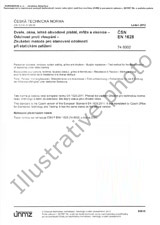We need your consent to use the individual data so that you can see information about your interests, among other things. Click "OK" to give your consent.
ČSN EN 16272-6 (736342)
Railway applications - Track - Noise barriers and related devices acting on airborne sound propagation - Test method for determining the acoustic performance - Part 6: Intrinsic characteristics - In situ values of airborne sound insulation under direct sound field conditions
STANDARD published on 1.2.2015
The information about the standard:
Designation standards: ČSN EN 16272-6
Classification mark: 736342
Catalog number: 96658
Note: WITHDRAWN
Publication date standards: 1.2.2015
SKU: NS-147821
The number of pages: 52
Approximate weight : 156 g (0.34 lbs)
Country: Czech technical standard
Category: Technical standards ČSN
Preview of the standard ČSN EN 16272-6 (736342)
We recommend:
Technical standards updating
Do you want to make sure you use only the valid technical standards?
We can offer you a solution which will provide you a monthly overview concerning the updating of standards which you use.
Would you like to know more? Look at this page.




 Cookies
Cookies
